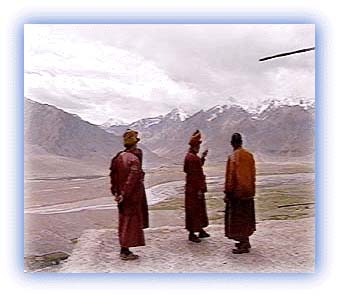Zanskar himalayas
General info
· Shingo La photo-feature
Approaching Zanskar from the Suru Valley
· Panikhar
· Penzella Pass
· Tangol
Zanskar Valley
· Shagma Karphu
· Padam
· Karsha
Rivers
· Zanskar River
· Khurana River
· Rangdom Gompa
· Phuktal Gompa photo-feature

![]()
| People The majority of the population of Zanskar are Buddhists. Probably, the mainstay of people's lives is their religion and attachment to the gompa (monastery). There are 9 major gompas and many other smaller ones at the village level. Every Buddhist family is associated with the gompa in or near the village. |
 |
| Lamas of the Gelugpa order Credit: Karamjeet Singh |
Traditionally, any family having a number of children sends a younger son or daughter to become a lama at the gompa to which the family owes allegiance. Though there is no age limit above which a child is not admitted for ordination as a lama, boys and girls are usually sent to the gompa at a very young age. When a child is marked out for a monastic life, he or she is taken to the gompa wearing the robes of a lama or chomo. The child's head is shaven amidst the recitation of scriptures.
The gompas have a great influence on the socio-economic life of the village as well. No function, ceremony or celebration is possible without the presence and religious services of the lamas. The lamas are even responsible for decisions like sowing seeds and harvesting.
The gompas have been responsible for maintaining and preserving the cultural traditions of the people. Karsha is the largest Gelugpa monastery in Zanskar, its foundation attributed to the great translator Rinchen Zangpo. The Gelugpa are the orthodox sect of Tibetan Buddhism, owing allegiance to the Dalai Lama. The Rangdom Gompa is another very impressive gompa in Zanskar.
 |
| Bardon Gompa Credit: Jarkko Lavinen |
The features of Tibetan feudalism were carried over to the Zanskar and hence the gompas hold a substantial amount of land. In Zanskar, arable land is very limited and this situation has led to a powerful link between the villagers and the gompas. Most of the lands are cultivated by the villagers on behalf of the gompas. In return, the gompas get grain and butter.
Butter, incidentally, is a highly valued commodity in Zanskar, with a wide variety of uses. It is the major energy and light source and serves as a fuel for the little lamps used in the houses and the bigger ones in the gompas. In addition, butter is the most important source of dietary fat for the people of this cold region. They drink a beverage of tea with butter and salt many times a day. Butter is applied as a salve on wounds as well. The most valued butter comes from Yak milk, since it has a very high fat content. Butter is thus the ultimate gift in Zanskar!
The Zanskar economy still functions in the framework of the barter system, with butter and other dairy products being the most valuable trade products.
All rights reserved